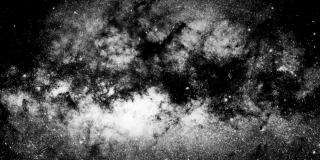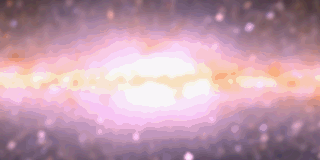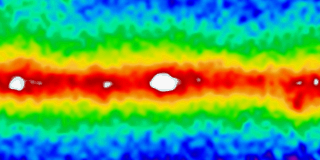
Astronomy 162: Professor Barbara Ryden
The center of our galaxy can't be seen at visible wavelengths. The image immediately below is a photograph at visible wavelengths of an area 20 degrees by 40 degrees centered upon the galactic center. As you can tell, there's a lot of dust between us and the center of the galaxy.

To observe the galactic center you can look at longer wavelengths (as in the infrared photo immediately below, which covers the same area of the sky as the visible photo). In the infrared photo, the dimming by dust is much less, and we can see that the center of the galaxy is actually quite bright.

Alternatively, you can look at very short wavelengths (as in the false-color gamma ray image below, which covers the same area of the sky as the visible and infrared photos).

Infrared light is useful for studying stars near the galactic center. Infrared light of about 2000 nanometers is emitted copiously by cool stars (K and M stars), but is not strongly scattered or absorbed by dust. Within a parsec of the galactic center, the estimated number density of stars is about 10 million stars per cubic parsec. By contrast, the number density of stars in the Sun's neighborhood is a puny 0.2 star per cubic parsec.
Because stars are so closely packed together near the galactic center, the night sky for inhabitants there would be spectacular. Near the galactic center, the average distance between neighboring stars would be only 1000 AU (about a light-week). If the Sun were located within a parsec of the galactic center, there would be a million stars in our sky with apparent brightness greater than Sirius. The total starlight in the night sky would be about 200 times greater than the light of the full moon; you could easily read the newspaper at midnight, relying on starlight alone.

Zooming in, radio observations of the central 10 parsecs of our galaxy
reveal the presence of a ``mini-spiral'' of hot gas.
A radio image of the mini-spiral is shown
below:

[Image credit: K.Y. Lo, University of Illinois, Urbana]
At the center of the mini-spiral is a strong,
very compact radio source called Sagittarius A*
(pronounced ``A-star''). Sagittarius A* has a radio
luminosity equal to 5 times the luminosity of the Sun.
High-resolution radio imaging reveals that Sagittarius A*
is only 1 AU in radius. What is Sagittarius A*, exactly?
Well, we can say what it isn't:
Additional support for the hypothesis that Sagittarius A* harbors a massive black hole comes from the recent discovery that Sagittarius A* is also a potent source of X-rays. Only very hot gas emits X-rays (for instance, gas that is being compressed as it falls toward a black hole...)
A star orbiting Sagittarius A* with a = 1000 AU has P = 20 years or so. It's easy to trace out the elliptical orbit of such stars between one year and the next. (The Max-Planck-Institut fur extraterrestrische Physik has a fascinating animation of stars orbiting Sagittarius A*. The best calculation, from all the observed stellar orbits, is that the central supermassive black hole within Sagittarius A* has a mass of 2.6 million Msun (and thus has a Schwarzschild radius of 0.05 AU, too small to be resolved from our location in the galactic suburbs).
If the black hole has grown steadily during the lifetime of the galaxy, its growth rate is equal to its current mass divided by its age. Assuming that the black hole is as old as the galaxy itself,
Growth rate = 2.6 million Msun / 13 billion years = 1 Msun / 5000 years. Thus, the black hole need only gobble up one Sun-like star (or its equivalent in interstellar gas) every 5000 years to keep itself fed.
Updated: 2003 Feb 20
Copyright © 2003, Barbara Ryden